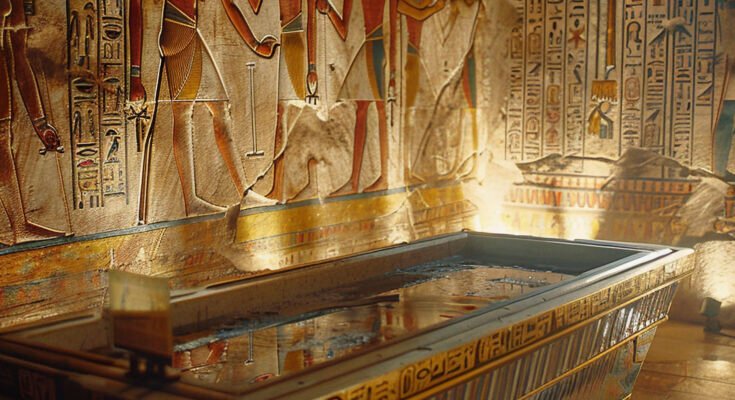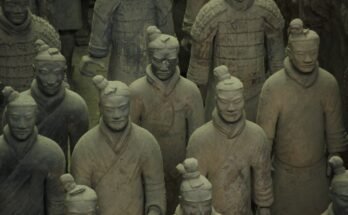Ancient Egypt, frequently extolled as one of the earliest and most influential civilizations in history, has left a legacy that proceeds to captivate and communicate with modern-day culture and science. Description of this civilization spans numerous millennia, from its inception, with 3100 BCE offering a date of its genesis, to 332 BCE, when Alexander the Great made his conquest. Monumental architecture, sophisticated society and an equally profound spiritual belief system are some of the many contributions Ancient Egypt made in mathematics, medicine, architecture and philosophy. However, ancient Egyptian civilization can be subdivided into several distinct periods, each characterized by a unique set of accomplishments, rulers and cultural developments.
The Emergence of a Single Empire during the Early Dynastic Period (3100–2686 BCE)
Ancient Egypt began as a single, loving family during the Early Dynastic Period. This is when some clever folks managed to join Upper and Lower Egypt together, which was a pretty big deal back then. The legend goes that a king named Menes (or Narmer, if you’re into the fancy stuff) was the guy who pulled this off and became the very first pharaoh of a united Egypt. He picked Memphis as the place to rule from, which became the center of it all.
These early pharaohs were like the cool kids on the block, setting up the foundation for a strong and organized society. They saw themselves as gods walking the earth, keeping everything in balance and fair, which is what ma’at is all about. They also started scribbling down their stories and important info using hieroglyphs, which are basically fancy pictures that tell a story. This was the start of them keeping records and passing down their culture.
Let’s get into the tombs. These tombs were similar to those early structural drafts that led to the mega-architecture of the pyramids that we know and love. That exhibited their architectural prowess with a gigantic sense of scale that would continue to expand in scale and quality as time went on.
Pyramid Age of Ancient Egypt: 2686-2181 BCE
Also known as the “Age of the Pyramids,” during which the immense pyramids were built at Giza, Djoser, Sneferu, Khufu, and Khafre collectively witnessed the unparalleled structures of creativity, wealth, and concentrated power in ancient Egypt. The first large stone monument was a step pyramid conceived by Djoser, thanks to the architect Imhotep. Along with the Great Pyramid of Khufu in Giza, it stands as one of the Seven Wonders of the Ancient World, and still, today built with the phenomenal feats of engineering and crafting as a wonder to behold.
The Old Kingdom was a period of artistic and cultural flowering, evidenced by detailed sculpture, bright mural painting, and opulent jewelry that embellished temples and tombs. Egyptians believed in an afterlife into which they could not enter unless their body was preserved, this mummification process provided provisions to retain the dead intact forever. The ka (soul) was believed to have some abode of its own in the shape of a pyramid confinement or an elaborate tomb that served as the house of the ka, live forever in the perceptible world.
However, as with the classical development of Egypt states and societies throughout Egyptian history, anarchy began to collect as these local governors (nomarchs) continued to gain power, while in the meantime diminished resources and weaker governance came into play, bringing down the Old Kingdom altogether.
A Period of Fragmentation: The First Intermediate Period (2181–2055 BCE)
Political and social disarray and fragmentation were characteristics of the First Intermediate Period.Regional rulers made a bid for power with the weakening of the central authority, leading to the division of Egypt. Civil wars, famine, economic dislocation, and instability characterized the period, during which rival dynasties, especially those based in Herakleopolis in Lower Egypt and Thebes in Upper Egypt, contended for influence and control over the ancient land of Egypt.
Despite these varied circumstances, the arts and literature flourished. Regional leaders commissioned works in their own regional styles and which epitomized local values. The Egyptian culture became more democratic during this time, and tomb inscriptions show that during the period ordinary people began to record their own achievements and virtues, a right previously reserved for royalty alone; hence–V. the first wave of cultural achievement initiated by ordinary citizens suggesting a clear paradigm change.
The Middle Kingdom (2055 BCE – 1650 BCE): The Reunification and Flourishing of Egypt
Nineteen years into Amenemhat III’s reign, there arose fully fledged Middle Kingdom. After the First Intermediate period, Thebes communicates that around 2055 BCE, King Mentuhotep II has allowed to reunite Egypt; however, precisely in this period, regards to golden age phase for Egyptian culture, literature, and administration, existent. The Kings of the Middle Kingdom were presided over by the defense of Egypt’s territories, especially in Nubian country to the south, where they inhibited the control of gold mines and trade routes.
The Middle Kingdom rulers worked on administrative reforms with the primary goal of restoring central power. Massive building projects were undertaken by Pharaohs such as Amenemhat I and Senusret III, comprising temples, fortresses, and a network of canals for improved irrigation systems. The period’s art and literary works began to reflect a new realism, with tomb decoration and literary works about daily life, along the fabric and suffering of human existence. Realism almost went to the extreme in aspects of portrayals of merchant classes; Middle Kingdom art presented kings with the facial expressions of reason and endurance rather than the idealistic portrayals sustained in earlier periods.
Barring fading due to internal weakness, the Middle Kingdom was matched by increasing pressure from foreign groups, particularly the Hyksos, who were able to influence yet another growth of armies in Egypt owing to centrally controlled warfare.
The Second Intermediate Period (1650 BCE – 1550 BCE): The Hyksos and Foreign Influence
The Second Intermediate Period was marked by the incursion of the Hyksos, a Semitic-speaking people who continued to settle in the Nile Delta and eventually gained control over Lower Egypt. Among the technologies that Hyksos received were advancements in metals and the chariot, the latter to occupy a central stage in warfare in Egyptian campaigns.
During the reign of the Hyksos in the north, native Egyptian kings continued to govern from Thebes in Upper Egypt. This period came to characterize the continuing conflict between the rulers of Thebes and the Hyksos, culminating in the reunification of Egypt. Eventually, Ahmose I, a prince of Thebes, successfully expelled the Hyksos and initiated a new epoch of unity and prosperity in Egypt.
The New Kingdom (1550 BCE – 1070 BCE): The Age of Empire
At times, New Kingdom fame defined a station of arch-civilization for Ancient Egypt. Spanning these regimes, Hatshepsut, Thutmose III, Akhenaten, and Ramses, built armies that expanded Egyptian territory through destablizing alone and trade trips reaching as far as Punt (what is Somalia today) and Near East. Wealth ensured large-scale construction out of stone that carved monuments like the rock-hewn temples of Abu Simbel, alongside the formation of temples at Luxor and Karnak.
During this time, the Constitution of Pharaohs was introduced, whereby they were to be brought before the public holiday as warrior kings, quasi-living gods on Earth. During this New Kingdom period, a shift in religiosity occurred, particularly during Akhenaten’s reign, in an attempt to establish a monotheistic worship of Aten-the sun disk. These religious reforms soon faded as Akhenaten’s death reinstated the polytheistic orientation.
The New Kingdom is also the time of the Valley of the Kings, or hidden tombs where the pharaohs were buried. The tomb of Tutankhamun discovered intact in 1922 contained a vast number of wonderful artifacts that offered great insight not just into burial practices but also into the artistry and quality of life during this period. Strong though the New Kingdom was, it failed in the end, with domestic strife from upper Egypt, the monetary crises, and threats from the Sea Peoples and neighboring empires.
The Late Period (664 BCE – 332 BCE): Decline and Foreign Conquests
Beginning with the New Kingdom, Egypt went through long and repeated cycles of foreign domination, Nubian, Assyrian, and Persian rule being prominent across this time. However, at this very time, the Saite Dynasty was a bright interval when Egypt rose in her own strength, made much of her ancient glory, and undertook monumental constructions.
332 BCE saw the conquest of Egypt by Alexander the Great, ushering the extinction of Egyptian civilization as an autonomous entity. As a precursor to the Ptolemaic Period, the conquest of Alexander laid the groundwork for Greeks to assume governance of Egypt, intermingling Hellenistic culture with Egyptian traditions.
Religions, Society, and Achievements of Ancient Egypt
Religiosity: Religion filled every dimension of Egyptian life and gave meaning to nature and every human experience, with gods and goddesses representing different domains in this regard. Among the most important gods were Ra, the sun god; Osiris, the god of the afterlife; and Isis, the goddess of fertility and motherhood. These were then implanted in the rituals Egyptians performed to their deities, most significant of which were the temples, which proudly embodied their reverence.
Social Structure: Egypt had a set caste system running from the all-powerful pharaoh to the priests, nobles, and high-ranking administrators, above whom sat the middle class of artisans and scribes, and finally, the bulk that was constituted of farmers and laborers. Though the slaves were there, they were often still captives of war, which could thereby allow them to integrate into society during their lives.
Accomplishments: In several areas of knowledge and practices, ancient Egypt may be described as one of the great evolutions of culture. These included pioneer surgery, a calendar based on astronomical observations, and geometry that led to the building of their great monumental architecture. Egyptian hieroglyphs and demotic forms of writing were extensions into which they recorded; this embracing of achievements, religions, and is operational.
conclusion
By way of conclusion, Ancient Egypt occupies a place of prominence in the history of the human civilization and its cultural, architectural, and scientific syntheses would continue to inform and inspire the modern world. The Egyptian accomplishments, ranging from the unification of Upper and Lower Egypt to the construction of monumental pyramids, exquisitely intricate art, and sophisticated administration, constitute a singular synthesis of enterprise and spirituality. The very devoutness of the Egyptians towards the concept of the afterlife and the preservation of their knowledge and culture through hieroglyphic writing has been of immense benefit to us in gaining an insight into their lives, societies, and values enduring through time.
For its capacity for survival and adaptation has allowed Ancient Egypt to ebb and flow through the millennia notwithstanding occasional fragmentation and foreign dominion. It is through medicine, mathematics, engineering, and literature that the stages of Ancient Egypt testify on behalf of their lasting legacy for the future generations. Ever since the Valley of the Kings and treasures like Tutankhamun’s tomb were unearthed, the intrigue of Egypt has captured the imagination of the world, ensuring that the legacy of Ancient Egypt remains as alive and relevant in modern times.




Hmm it looks like your site ate my first comment (it was super long) so I guess I’ll just sum it up what I wrote and say, I’m thoroughly enjoying your blog. I too am an aspiring blog blogger but I’m still new to everything. Do you have any tips for first-time blog writers? I’d certainly appreciate it.
thank you, sir